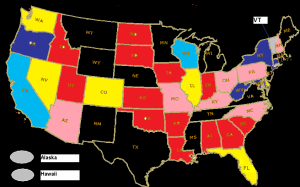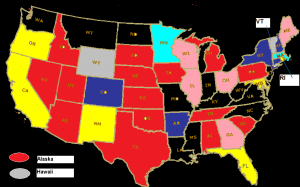2010 Election Predictions – How we rank individual races
Our calls on individual races are based on a composite of polls conducted over the last 28 days (we will compress this “look back period” to 14 days after Labor Day, since that’s when voters will start to pay attention to these races) using the following criteria:
(1) Safe Democratic (dark blue on the map)/Safe Republican (dark red on the map) – either a candidate leads by 10 or more points, or a candidate has over 50% in polls;
(2) Lean Democratic (light blue on the map)/Lean Republican (light red on the map) – a candidate leads by 3-9 points;
(3) Tossup (yellow) – a candidate leads by less than 3 points;
(4) No data available/primary has not been held (gray) – In general, we don’t analyze statewide polls until its primary has been conducted. However, since pollsters have been releasing multiple polls with different Democratic vs Republican matchups for states that have not held their primaries, we will modify this rule as follows: if at least one of the major parties has a clear front runner in a contested primary, we will use the various poll matchups to get a sense of how a Senate/Governor race is leaning and, based on that composite of polls in the last 28 days, will assess which party is ahead.
(5) No Senate/gubernatorial race in 2010 for this state (black);
Since the last poll analysis, two things have changed – (1) polling firm Public Policy Polling (PPP) is now using a “likely voter” model for determining its poll sample – this theoretically will produce more Republican poll samples, and (2) Rasmussen is now forcing those leaning towards a candidate to state a choice (this action will cause the undecided number to plummet) – we will report both numbers Rasmussen uses.
2010 Election Predictions – Senate Races
(8/19 projection: 55 Democrats, 45 Republicans, or Republican gain of +4)
(8/4 and 8/11 projections: 54 Democrats, 46 Republicans, or Republican gain of +5)
Since our last analysis, we have made four changes: (1) Georgia has entered the analysis as “solid Republican”, (2) in the aftermath of the August 10 Colorado primary, initial polling shows a tossup race, (3) we are moving Delaware and Nevada to “tossup” – in Nevada, recent polling out shows a very tight race between Harry Reid and his opponent, while in Delaware, the race appears to be a tossup: since the primary is not until September 14, the Democratic candidate either leads or trails by double digits, depending on who his Republican opponent is, and (4) finally, while recent polling shows 18 year incumbent Patty Murray (D-Washington) with slight poll leads, we are keeping this race as a “tossup”: Washington just held its primary several days ago under an open primary system where anyone can vote, and so far (only 67% of the vote has been counted), Senator Murray has received 46% of the vote, while the combined Republican vote is hovering around 50%. In effect, we are getting what we believe is an early indicator of the November results for that state.
Several things on the map are also worth noting: (1) while we have no poll data for the Alaska, Hawaii, and Vermont Senate races, we expect that those will be classified as “safe Republican” (for Alaska) or “safe Democratic” (for Hawaii and Vermont) as data comes available; (2) though Wisconsin is “leans Democratic”, we need to reiterate that this is a 28 day average of how Russ Feingold would poll against multiple Republican candidates. Against GOP front-runner Ron Johnson, Feingold either trails or is tied in the polls – once Wisconsin holds its primary on September 14, we can probably reclassify this race; (3) in addition to Wisconsin and California, another Democratic held seat we are watching for possible reclassification is the Connecticut Senate race. Though Democratic Attorney General Richard Blumenthal has led in the polls, his numbers have steadily eroded. Since Connecticut has now held its primary, we believe that Blumenthal’s numbers will continue to erode against a single GOP opponent – in fact, a recent Rasmussen poll shows him with a 47-40% lead over Republican nominee Linda McMahon;
2010 Election Predictions – Governor’s Races
(8/11 and 8/19 projection: 32 Republicans, 18 Democrats, or Republican gain of +8)
(8/4 projection: 31 Republicans, 19 Democrats, or Republican gain of +7)
Since our last analysis, there have been two offsetting changes to our predictions. First, we have moved the Wisconsin Governor’s race from “Tossup” to “Leans Republican” (keep in mind that their primary is not until “Super Tuesday II” on September 14, but the likely Democratic nominee trails against either of the two leading Republicans). In Connecticut, there has been a poll conducted since its August 10 primary which shows the Democratic nominee with a substantial 48-33% lead – since this is a seat where the Republican incumbent is term limited, if these poll numbers held up, this would be a Democratic pickup.
A couple of things on the map are also worth noting: (1) while we have no poll data for Hawaii, Vermont, and Wyoming, we expect to see Wyoming data very soon – they held their primary this past Tuesday; (2) three of the states where Democrats lead in the polls are due to third party candidacies. In Colorado, the Republican and Constitution Party candidates are getting a combined 51% (as opposed to the Democrat ‘s 45%). In Minnesota, the Republican/Independent total is 44%, compared to the 42% the Democrat is receiving. Finally, in Massachusetts, the embattled Democratic incumbent leads in the polls with an anemic 34%, while the Republican + Independent total is 45%.
2010 Election Predictions – Generic Congressional Vote
(8/19 poll composite: 46.6% Republican, 41.2% Democrat – +5.4% Republican)
(8/11 poll composite: 45.3% Republican, 41.3% Democrat – +4.0% Republican)
(8/4 poll composite: 45.2% Republican, 41.7% Democrat – +3.5% Republican)
With recent statements by both President Obama and House Speaker Nancy Pelosi (D-California) suggesting support for building a mosque near “Ground Zero”, it’s not surprising that the Democrats have had a bad week. Accordingly, while poll numbers continue to show movement towards Republican in overall voter preference, the Republican preference spiked from 45 to 47% this past week. To put the “Generic Congressional Vote” question in perspective, when Republicans retook the House (and Senate) in 1994, the popular vote in the 435 House districts was 52-45% Republican. If we were to split the undecideds equally between both parties, you would have a 53% Republican vote, which equates to a 229 seat Republican majority – a net gain of 50 Republicans, or 11 more than needed to regain control of the House. We also believe at this time that the 229 seat figure is a conservative estimate, since it doesn’t consider voter intensity, which clearly favors the Republicans right now. There’s another factor at play too: voters are not happy with Congressional incumbents, and in a recent Rasmussen poll, only 37% wanted to re-elect their own Congressman. Since 60% of incumbent House members are Democrats, this is obviously not a sentiment the Democrats want voters to have.
2010 Election Predictions – Individual House Races
(8/4 and 8/11 : 257 Republicans/178 Democrats (Republican gain of +78, 19 Democrats on the “watch list”)
One of the things we have repeatedly noted in our discussions of the “Obama plunge” and its effect on the fall elections is that actual poll results (and in the case of Washington state, open primary election results) take precedence over the theoretical criteria used to determine whether a seat is vulnerable. This past week, we have seen polls released for 31 House races. Though the numbers above would seem to signify a Democratic renaissance, the truth is actually the opposite. What we saw was the following:
(1) In 20 of the 31 House races, polling data confirmed our belief as to who was safe, on the “watch list”, or vulnerable;
(2) Three formerly safe Democrats: Sanford Bishop (D-Georgia), Russ Carnahan (D-Missouri), and Dan Maffei (D-New York) are now on the “watch list.” Interestingly, all three Democratic incumbents supported the “Big Three” (stimulus, “cap and trade”, and the five times healthcare reform was voted on). On average, these Congressmen represented districts that voted 57% for Obama;
(3) Four theoretically vulnerable Democrats moved to the “watch list” based on poll numbers showing them in the lead but with less than 50%: Jim Himes (D-Connecticut), Scott Murphy (D-New York), Bill Owens (D-New York), and Rick Larsen (D-Washington) – in Larsen’s case, he led in the open primary with only 43%. On average, Obama got 55% of the vote in these districts, and all four have at least one “yes” vote on healthcare reform on their permanent record;
(4) There are a handful of Republican seats which are vulnerable. The open seat in Delaware is one of those seats, as an open seat plus a strong Democratic challenger (Lt Governor John Carney) makes this one of very few races Democrats can feel good about. Initial polling shows him with comfortable leads (but with less than 50%) over either of two possible Republican challengers, so we are putting this seat on the “Watch List”;
(5) Two incumbent Democrats: Walt Minnick (D-Idaho) and Nick Rahall (D-West Virginia) have released polls showing them in the lead with over 50%, so we are moving from the “watch list” to “safe Democrat”;
(6) Democrat Mark Critz won in an upset in a May special election by promising to be a conservative Democrat. His voting record hasn’t lived up to that promise, and he trails 40-44% in the polls against the same Republican he defeated in May with 53% of the vote;
A final note on the polls so far: we have seen polls done on 22 Democratic held seats where the Democrat is behind in the polls. On average, these districts voted 51% for Obama, which means that these seats are “Ground Zero” for the “Obama plunge.” Similarly, we have seen poll results for an additional 18 Democratic held seats where Democrats lead but with less than 50% – Obama on average got 52% in these districts, and these seats are similarly vulnerable against the “Obama plunge.” These 47 House seats alone can flip the House to Republican control.
John is a political consultant and blogger with JMC Enterprises with expertise in poll sample development and analysis, development of targeted voter files for phone canvassing or mail outs, campaign strategy and demographic consulting, among other things. See his site at WinWithJMC.com for more information.
Advertisement
Advertisement


